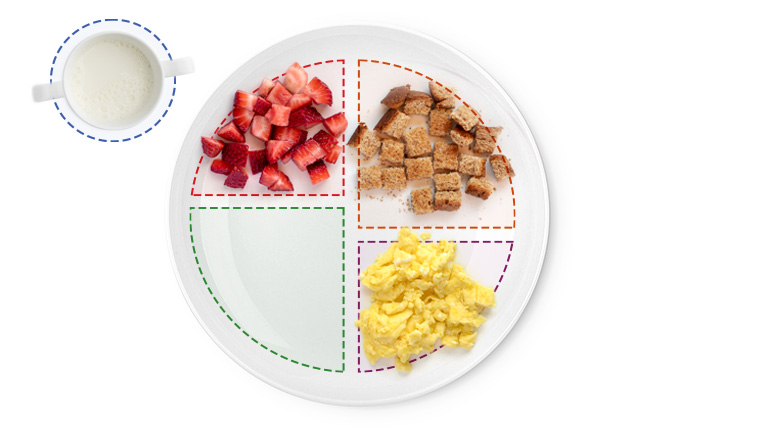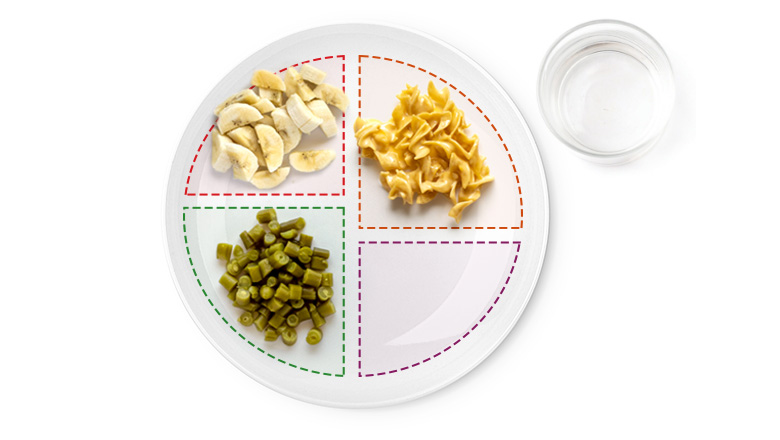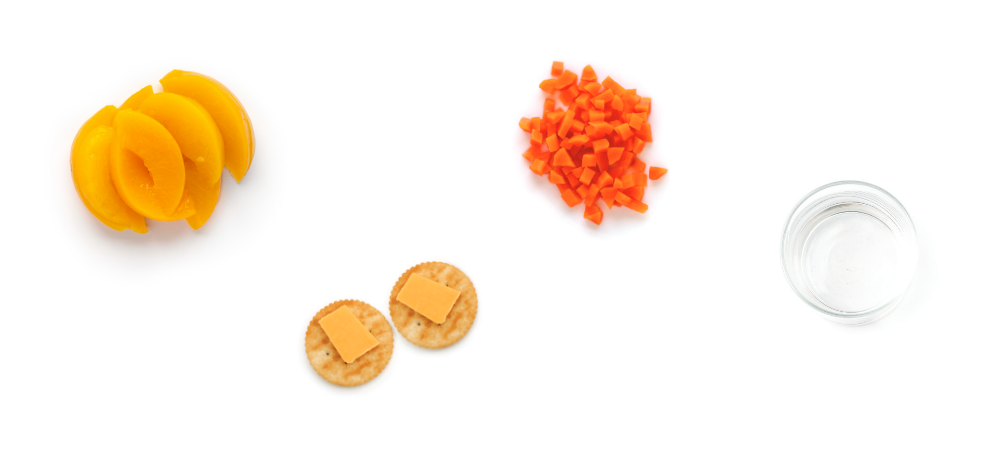I am growing and learning every day.
I need your help to be a good eater and try new foods!
What
- Offer small amounts (1 to 2 tablespoons) of several foods, even ones you don’t like.
- Offer me a new food along with a familiar food.
How
- Let me use my spoon, fingers, or both. I learn by smelling, tasting, and touching food.
- If I don’t like a new food right away, that’s ok! Offer it again at another time. It might take 10 or more times before I decide to try it.
- Please don’t force me to eat. Let me eat my way – fast or slow.
When
- I need a routine. Let’s eat at the same times every day.
- My stomach is still small, so I get hungry every 2 or 3 hours.
- I do best with 3 meals (breakfast, lunch, dinner) and 2 or 3 snacks.
- I only need water between meals and snacks.
Where
- Eat with me. Learning new things can be scary. I feel safe with you and will learn best with your support.
Here are some examples of what meal and snack portion sizes might look like on my plate.
Breakfast
¼ cup diced strawberries
½ cup human milk or whole milk

½ slice, cut up whole grain toast
½ cooked, cut up egg
Lunch
½ medium, sliced banana
¼ cup cooked, chopped green beans

¼ cup whole grain macaroni and cheese
½ cup water
Snacks

½ cup sliced peaches
2 to 3 whole grain crackers with cheese
¼ cup cooked, chopped carrots
water between meals and snacks
Dinner
¼ cup applesauce
½ cup cooked, cut up broccoli

1 medium, cut up corn tortilla
¼ cup cooked, mashed pinto beans
½ cup human milk or whole milk
Daily Suggested Food Group Amounts
½ – 1 cup a day
Cooked or soft, raw fruit.
Mashed, sliced, or chopped.
Offer a variety: red, yellow, orange, blue, and green.
2/3 – 1 cup a day
Cooked and mashed, sliced, or chopped veggies.
Offer a variety: dark green, orange, red, yellow, and purple.
1 ¾ – 3 ounces a day
Bite-sized pieces.
Whole grain bread, tortillas, rice, or noodles.
Dry or cooked cereal.
1 ¾ – 3 ounces a day
Bite-sized pieces.
Whole grain bread, tortillas, rice, or noodles.
Dry or cooked cereal.
2 ounces a day
Cooked, chopped meat, poultry, or fish.
Eggs.
Cooked beans, peas, or tofu.
Peanut butter.
2 ounces a day
Cooked, chopped meat, poultry, or fish.
Eggs.
Cooked beans, peas, or tofu.
Peanut butter.
1 2/3 – 2 cups a day
Human milk (at breast or expressed) or whole milk.
Yogurt.
Cheese.
Dairy
1 2/3 – 2 cups a day
Human milk (at breast or expressed) or whole milk.
Yogurt.
Cheese.
Look what I can do!
- I understand a lot of what you say. Read, talk, and sing to me so I can learn more!
- I like to copy what you do. Let me play with a bowl and spoon. I will pretend to stir food just like you do.
- I am still learning how to use a spoon and cup. Please be patient with my mess.
- I can use my hands to stack blocks, throw a ball, and push and pull toys. Play with me!
Keep me safe and healthy.
I love to run, jump, and climb. Watch me when I’m active so I don’t get hurt.
I like to explore. I open doors and drawers to see what’s inside. Let me learn, but keep me safe.
Please DON’T give me foods I could choke on like whole nuts, whole grapes, seeds, hot dogs, or hard candies.
I need check-ups and shots to stay healthy. I should visit the doctor at 18 months and 2 years. Visit www.cdc.gov/vaccines/schedules to see when I am due for shots.
If I haven’t seen the dentist yet, make my first appointment. I should be brushing my teeth twice a day. Ask my dentist how to keep my teeth healthy.
Play with me and help me stay active. If I have screen time, keep it limited and interact with me.
Avoid tobacco or nicotine products, alcohol, marijuana, and other illegal drug use to keep our family healthy and safe. For support with quitting tobacco or nicotine products, visit www.quitnow.net. For support with quitting alcohol or other drugs, visit www.findtreatment.gov. Your WIC Nutritionist can also provide additional resources.